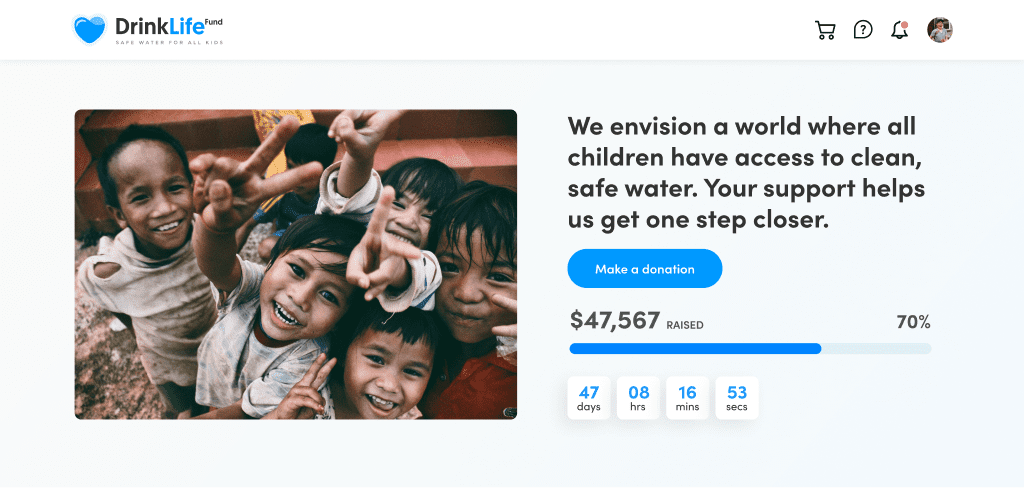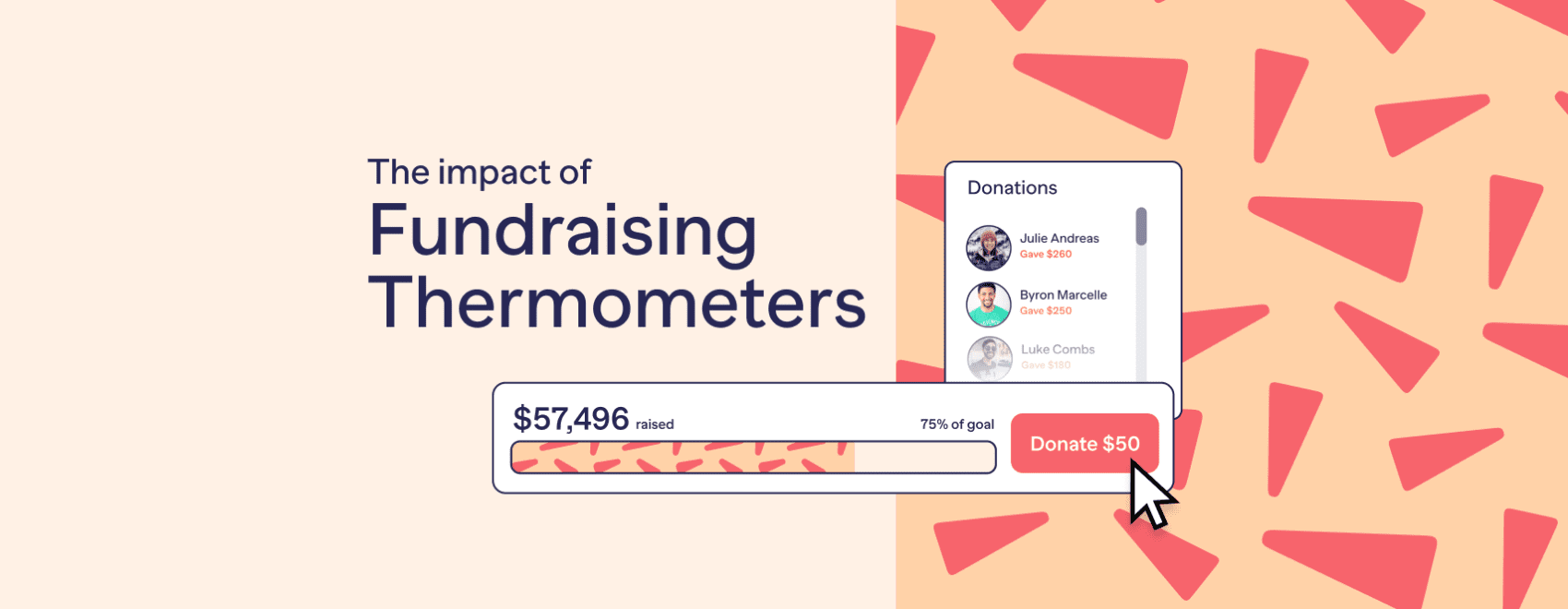Whether you’re new to fundraising or are a seasoned expert, you’re probably familiar with the concept of fundraising thermometers. Most people recognize fundraising thermometers when they see them attached to prominent in-person or virtual fundraising campaigns. Still, there’s a lot of confusion around when and how they can be used to boost fundraising efforts.
This article will answer the questions:
- What is a fundraising thermometer?
- When should fundraising thermometers be used?
- Who should use a fundraising thermometer?
- How to ensure my fundraising thermometer sets me up for success?
- How can I get a fundraising thermometer?
It will also share the dos and don’ts of using a fundraising thermometer and explore how you can use a fundraising thermometer to boost donations during your next fundraising experience!
What is a Fundraising Thermometer?
A fundraising thermometer, sometimes called a fundraising goals tracker, a donation thermometer, a charity thermometer, or a fundraising chart, is a visual representation of your fundraising goal that ‘fills up’ as you receive more donations. While each fundraising thermometer might look slightly different in shape, size, and design, they all provide a clear visual of how much money has been raised towards an organization’s goal. When zero dollars have been raised, the thermometer is empty; when the goal has been reached, it’s full. As donors give, they’ll see their contribution raise the thermometer in proportion to have much they have towards the goal. Fundraising thermometers are important because they provide a quick, visual look at your fundraising campaign’s health. Donors want to be a part of something big so, when they see a fundraising campaign with a rapidly rising thermometer, they’re more likely to give.

When should fundraising thermometers be used?
Fundraising thermometers have been used for generations to help organizations of all sizes reach their fundraising goals. In general, fundraising thermometers should be used when an organization has a set goal and is actively fundraising to achieve it within a specific period of time. Fundraising thermometers should not be used when there is no particular goal or no specific campaign. While it can help organizations internally track how much money they need to raise overall in a year, for example, a fundraising thermometer would not be the best way to track how much you’ve raised and how much you still need to raise. If, however, you have a month or months-long campaign with a specific goal and a specific end date, a fundraising thermometer may be a great way to track progress and motivate your current and potential donors to give.

Who should use a fundraising thermometer?
Organizations and nonprofits of any size can use fundraising thermometers. Whether the goal is $1000 or $10,000,000, fundraising thermometers can provide the motivation needed to help donors keep giving. Fundraising thermometers should not be used by organizations that do not have a clear goal in mind or that do not plan to actively work to raise the funds they need to meet their goal.
How to ensure my fundraising thermometer sets me up for success?
When deciding to use a fundraising thermometer, organizations want to be sure that they’re doing everything they can to boost its effectiveness and help them raise more money. Follow the tips below to ensure you are on the right track.
- Don’t start on empty
When organizations consider adding a fundraising thermometer to their fundraising experiences, one of their biggest concerns is what to do if they’re not raising as much money as they’d hoped as soon as they had hoped. No one wants to broadcast to their supporters that they’re not raising as much as they’d hoped.
Organizations can avoid this problem but running a precampaign that ensures that their thermometer won’t ever appear empty to external donors. To run a successful precampaign, sometimes called a soft launch, you’ll need to identify a specific subset of supporters and donors who understand how vital their contributions will be and create a specific road map towards success for them to follow. You’ll also need to identify a manageable but aggressive precampaign goal as you’ll want to raise 20%-30% of your overall goal during this precampaign period. Often board members, internal stakeholders, and other large donors will form your supporter base for your precampaign.
Once you’ve reached your precampaign goal, you can launch your full, public campaign with confidence that you already look like a winning organization. Starting with money already raised helps your organization appear successful and trustworthy and allows later donors, who often give in smaller increments, to feel like they’re a part of something big.
- Make it ultra-sharable
The whole point of a fundraising thermometer is to show your donors that you’re making progress towards your goal, so you’ll want to be sure it’s easy to read, easy to spot, and easy to share. Your fundraising thermometer should take a prominent place on your fundraising page to ensure that it’s easy to spot and should update automatically so donors can see their contributions, making a difference in real-time. You’ll also want to be sure that your campaign page is easy to share so that donors can spread the word to their friends and family.
- Find additional ways to motivate donors
While a fundraising thermometer can help motivate your donors from the early stages through the very end of your campaign, simply having one on your page won’t single-handedly make your fundraising experience a success. To raise big funds, you’ll need to find additional ways to motivate your donors. Before you launch your campaign, consider all the ways you communicate with potential and current donors and how you can utilize these communication channels to motivate them to give. Often, organizations have success appealing to donors through email or social media or, more traditionally, with a letter.
Before you launch your campaign, you’ll also want to consider making it possible for donors to give in various ways that meet their individual needs and desires. For example, organizations can host a fundraising sale that allows donors to shop for friends and family, a raffle, which will enable donors to give a set amount for a chance to win a desirable prize, and a live fundraising event that encourages engagement and participation. With a mix of ways to give and get involved, more donors will find a way to give that works for them.
Other fun ways to boost engagement and excitement and motivate donors to give include offering prizes and incentives, putting a spotlight on your donor’s generosity with a public thank-you shout-out, or encouraging donors to spread the word about the organization they love with the option to raise money on your behalf through peer-to-peer fundraising.
- Stay Flexible
So, what happens if you reach your goal before your campaign end date and your fundraising thermometer fills up? Should you end your campaign early and call it a day? No! While you might worry that a full fundraising thermometer might work against you, in reality, it shows your donors that you’re good at what you do and that other people believe in you too. If the goal is reached early in the campaign, you can simply adjust the goal, make the top of the thermometer a little higher and keep on fundraising.
While it’s valid to be concerned about reaching your goal too early, doing so is much better than the alternative of not reaching your goal at all. Most organizations avoid this issue by working hard to set a realistic goal that they plan to exceed by just a little bit by the end of their campaign. To set a realistic goal, look at what past campaigns have raised, think about what you’ll do differently and who you’ll engage, and lay out a clear map of how you plan to encourage donors to give. Look at the range between what you know you’ll raise and what would be a real stretch goal, and set your campaign goal right in the middle. Having an achievable goal helps people feel good about giving and, remember, you can always adjust upwards if you meet your original goal early.
How can I get a fundraising thermometer?
Now that you know how valuable fundraising thermometers are and how to use one to help engage your donors and boost your total donations, you’re probably wondering how to go about getting one for your next fundraising experience.
Luckily, getting a fundraising thermometer for your fundraising experience is easy and completely free with RallyUp. You can learn more about all of RallyUp’s features and about how to ensure your progress bar takes center stage.
